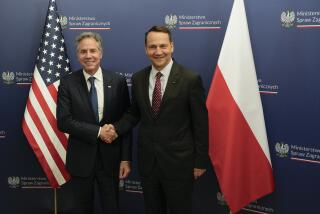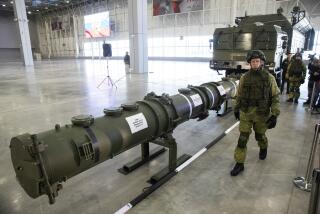U.S. Unveils Plan to Verify Missile Cuts : On-Site Inspection, Other Strict Measures Proposed to Soviets
WASHINGTON — The Reagan Administration on Thursday submitted to the Soviet Union proposals for on-site inspection and other highly stringent verification measures to police the medium-range nuclear missile treaty now being negotiated.
State Department spokesman Charles Redman, announcing the comprehensive proposal made to Soviet negotiators in Geneva, disclosed the measures in unusual detail, including the call for a “permanent presence” of U.S. officials in the Soviet Union--and Soviet officials in the United States--to monitor adherence to the treaty.
The verification package, probably the most sweeping ever submitted in arms negotiations, also provides for inspectors of one side to visit a suspect facility of the other side, on short notice and “on demand,” with no right of rejection of that demand, an Administration official told The Times.
No Sensitive Sites Exempt
In principle, the Soviets could demand to visit such sensitive sites as the CIA headquarters, but if they did, the United States would then demand to visit KGB headquarters, the official said.
“We expect that there would be mutual restraint shown on both sides,” the official said. “If they make an inspection that is patently not serious, they would be subject to an intelligence-gathering mission from us. And, since they stand more to lose than gain from such an exchange, we don’t think they’ll do it.”
Redman refused to say whether the monitoring would be done by remote-control instruments or individuals, but Administration officials said privately that the “presence” would consist of about 200 individuals on each side at between six and 14 facilities where the missiles are produced, assembled, stored, maintained and deployed. Inspectors also would be present when missiles were dismantled or destroyed.
Many of these provisions are certain to be controversial. Some experts doubt that such highly intrusive measures are necessary to monitor the proposed treaty, for example, and fear that Soviet objections to them will kill prospects for a new arms control treaty.
Others have cited difficulties in allowing Soviet officials to visit super-secret U.S. defense plants. Sen. Dale Bumpers (D-Ark.) has said that new domestic legislation would have to be enacted to permit Soviet inspectors at private U.S. facilities. But Pentagon officials said they doubt that new laws are needed, and Redman said it is “too early to tell.”
Soviet leader Mikhail S. Gorbachev has endorsed the principle of on-site inspection. He has even reportedly told U.S. visitors that the Soviets may be “more demanding” in their verification proposals, which have not yet been submitted. But few U.S. officials believe that the Kremlin will accept the onerous U.S. package in all its detail.
The U.S. verification measures disclosed Thursday are a late submission to a U.S. draft treaty put forward March 4.
The treaty, whose key points already have been accepted by the Soviets, calls for elimination of all intermediate-range nuclear missiles in Europe. Each side could retain 100 warheads outside Europe, but the Soviet weapons would be stationed only in Asia--the United States wants them all in a single base near Novosibirsk--while the U.S. weapons would be based in the continental United States.
The verification provisions for the treaty draft were delayed to permit consideration of objections from allied nations, particularly West Germany, whose bases would be subject to Soviet inspections because U.S. medium-range missiles are or will be stationed there under present deployment schedules.
After a meeting with senior officials from Britain, Italy, Belgium, the Netherlands and West Germany here earlier this week, an interagency group of U.S. officials hammered out the final verification proposal.
It has three basic objectives: to ensure confidence in the treaty, to deter violations and to permit “quick and unambiguous detection of any violations, thereby providing timely warning of a potential or real threat to allied security,” Redman said.
The six basic elements of the package:
--Non-interference with the listening and other monitoring devices of the other side, and particularly no more encoding of telemetry data from missile flights. This data, which includes engineering measurements on missile performance and capabilities, must be broadcast in the open. At present, the Soviets encode more than 90% of such telemetry, U.S. officials said.
--Specification of areas and facilities that are involved in all aspects, from production to deployment, of missiles covered by the treaty. If any missiles or their parts are then found in areas and facilities not designated, they will constitute treaty violations.
--Exchange of specific, comprehensive information on the missiles at the time the treaty is signed. Included would be how many missiles each side has, their location, their appearance--the United States has never seen the Soviet SS-20 missiles to be covered in the treaty--their range and other capabilities.
--Updating of this data, such as any change in the number of weapons as some are destroyed, in their location and in modifications of their characteristics.
--Special procedures for the destruction, dismantling and conversion of missiles to weapon systems that would not violate the treaty. Inspectors from the opposing side would be present at such events.
--As the most intrusive provision, on-site inspection and monitoring of all areas and facilities identified with intermediate-range missiles initially and for the indefinite future.
More to Read
Sign up for Essential California
The most important California stories and recommendations in your inbox every morning.
You may occasionally receive promotional content from the Los Angeles Times.










